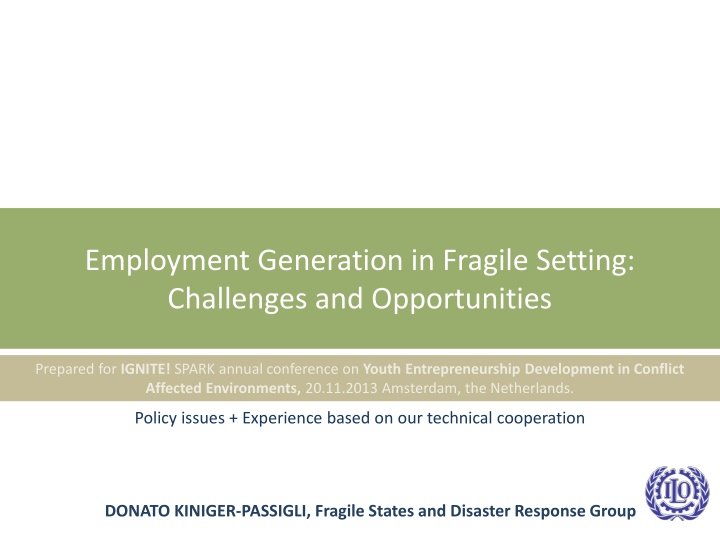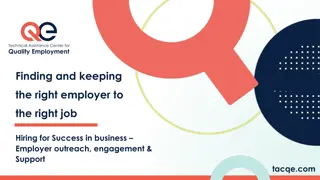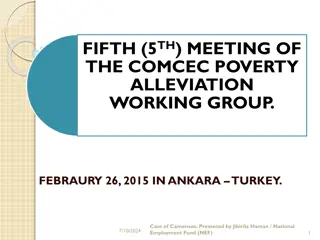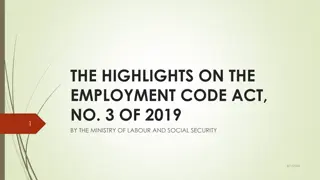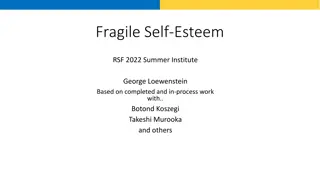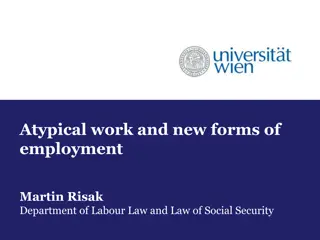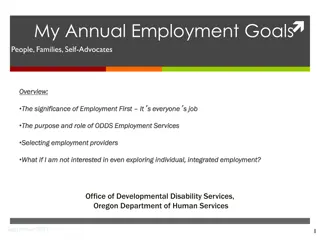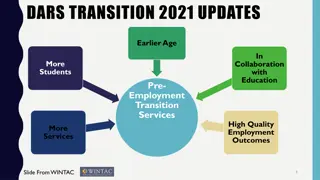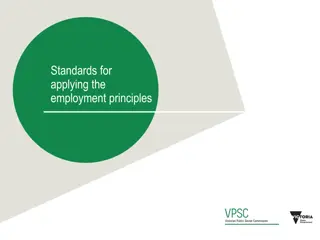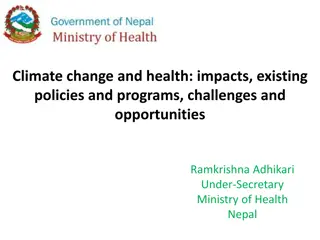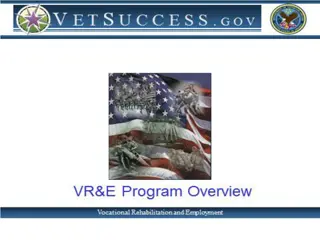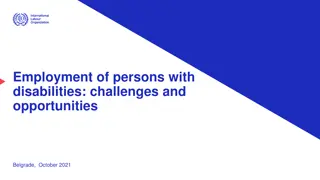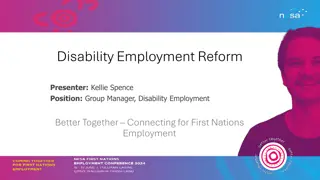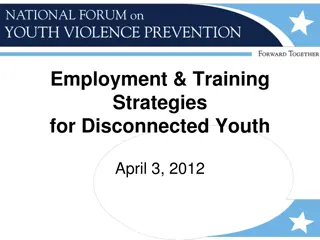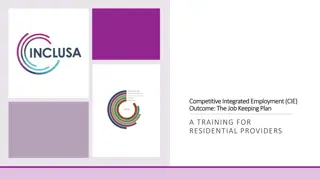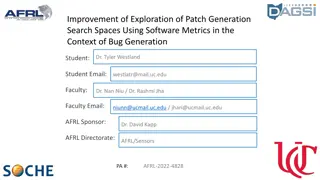Challenges and Opportunities in Employment Generation in Fragile Settings
Global youth unemployment crisis, skills mismatch, and the link between unemployment and violence are key challenges explored in this presentation. It emphasizes the importance of employment programs for youth in conflict-affected environments for peace and development, suggesting inclusive approaches and community-level reintegration strategies. The focus is on generating sustainable employment to foster stability and resilience.
Download Presentation

Please find below an Image/Link to download the presentation.
The content on the website is provided AS IS for your information and personal use only. It may not be sold, licensed, or shared on other websites without obtaining consent from the author.If you encounter any issues during the download, it is possible that the publisher has removed the file from their server.
You are allowed to download the files provided on this website for personal or commercial use, subject to the condition that they are used lawfully. All files are the property of their respective owners.
The content on the website is provided AS IS for your information and personal use only. It may not be sold, licensed, or shared on other websites without obtaining consent from the author.
E N D
Presentation Transcript
Employment Generation in Fragile Setting: Challenges and Opportunities Prepared for IGNITE! SPARK annual conference on Youth Entrepreneurship Development in Conflict Affected Environments, 20.11.2013 Amsterdam, the Netherlands. Policy issues + Experience based on our technical cooperation DONATO KINIGER-PASSIGLI, Fragile States and Disaster Response Group
Global (un)employment: Trends and perspectives Global youth employment crisis is worsening Global youth unemployment is estimated to be 73.4 million in 2013 Projections for 2014 show a further increase to 12.7 % Young people continue to suffer disproportionately from decent work deficits Young working poor equals to 3 times global unemployment Skills mismatch hampers the matching of jobseekers and job openings There is a mismatch between the skills young people possess and the skills that demanded by employers
Employment as a pathway towards stability, development and peace The importance of (youth) employment programmes in fragile settings is gaining increased international awareness.
Unemployment = violence? (Youth) unemployment is a key stress factors that drivers people to participate in conflict and violence. Motivations young people cited for joining militias: to escape unemployment 39,5% ideological reasons 13% World Bank 2011
Employment = peace? Key assumptions Lack of income + loss of livelihoods = conflict Employment generation = peace + stability but be aware of simplistic solutions: In fragile settings it is often the experience of employment, rather than unemployment, that is a main driver of conflict and violence Need for early employment generation with a systematic approach towards sustained development and resilience
Generating Employment in conflict-affected and fragile settings Inclusive approaches based on equity and security Community level reintegration Comprehensive labour market assessment, value chain analysis & training for the right trade Coexisting programmes and policies
Generating Employment in conflict-affected and fragile settings Community level reintegration Rebuilding communities Investments for local recovery and reconstruction Development of local capacities Creative solutions from local and global knowledge
Generating Employment in conflict-affected and fragile settings Inclusive approaches based on equity and security All programmes must be inclusive during stablisation/transition Target communities of reinsertion, not ex-combatants only Create immediate job opportunities, sustainable livelihoods and institutional capacity simultaneously
Generating Employment in conflict-affected and fragile settings Programmes geared to needs of youth emerging from conflict Attention to the supply side of labour but also to stimulus on demand Private-public partnerships to engage youth/enhance entrepreneurship Active role of social partners in conflict resolution Comprehensive labour market assessment, value chain analysis & training for the right trade
Generating Employment in conflict-affected and fragile settings Both, upstream and policy work and downstream stabilisation programmes are essential Livelihood recovery in the shortest possible time should coexist with employment-oriented strategies and local economic recovery Coexisting programmes and policies
Generating Employment in conflict-affected and fragile settings One Programme on Three Concurrent Tracks Peace Stabilization Transition Reintegration Negotiations Peace Agreement Pre-assessments Creation and Decent Work Sustainable Employment Target groups Nation Wide Hosting, Local Communities Basic Social Needs Income Security Inclusive approaches based on equity and security Community level reintegration Pre-Peace Accord Planning Comprehensive labour market assessment, value chain analysis & training for the right trade EMERGENCY EMPLOYMENT Coexisting programmes and policies Peacebuilding Process STABILIZING INCOME GENERATION & Track A LOCAL ECONOMIC RECOVERY FOR EMPLOYMENT AND REINTEGRATION Track B Track C SUSTAINABLE EMPLOYMENT CREATION AND DECENT WORK
Case studies: Over the past 15 years the ILO technically coordinated development projects in over 30 conflict-prone countries 28/02/2025 Recuperaci n Econ mica Local 12
Before implementing programmes Think YOUTH! Promoting youth employment is a challenging endeavour Building the future of societies Facilitating peace and stability Y O U T H OUNG PEN Key question for success: NDERSTANDING How do young people experience and perceive employment opportunities? RUSTWORTHY UMBLE
Case Study: Liberia 2009 Target groups Direct beneficiaries: ex-combatants Indirect beneficiars: youth Opportunities Institutional support of Government and civil society Skills training and employment Empowerment through social cohesion Decent work promotion for youth (informal economy/agriculture, waste management, construction) Challenges 14 years of war hindered basic education Children/youth were the bulk of (forcefully) recruited fighters A lost generation that never experienced peace in their lifetime
Case Studies: Sierra Leone and Burundi 2011 Target groups Direct beneficiaries: ex-combatants Indirect beneficiars: youth Challenges Transition countries, fragile post-conflict recovery, crisis of traditional societies Low life expectancy (average age 17) Massive number of unemployed youth (60%) Youth vulnerable to recruitment for criminal activities/spoilers Poor infrastructures, no institutional capacity Plethora of uncoordinated employment programmes Opportunities Integrated approach to job creation based on short term and long-term employment and reintegration programme. Maximise employment impact of existing programmes and investments. 3 tracks/strategies: 1) Livelihood stabilization 2) Local economic recovery 3) Long-term employment and inclusive economic growth
The Seven Es for Operating in Fragile Settings EDUCATION ENGAGEMENT EMPOWERMENT EQUITY EXPECTATIONS ENTREPRENEURSHIP EXPERIENCE 16
